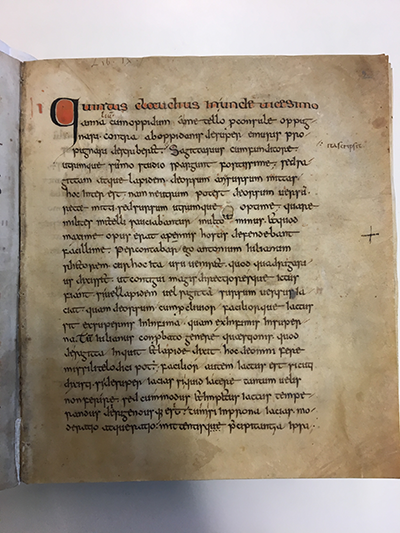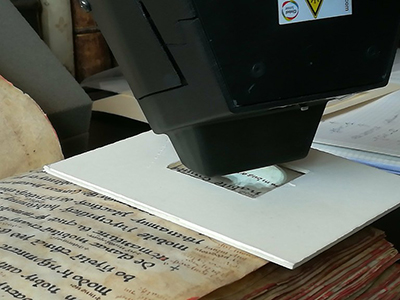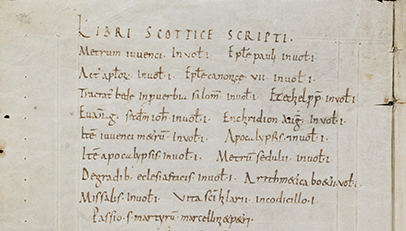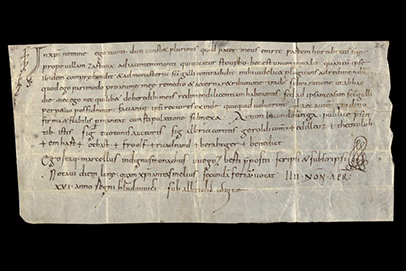Insular Manuscripts
Knowledge exchange: people and places
The last of three workshops organised by the Insular Manuscripts Network took place at the Institut für Mittelalterforschung der Österreichische Akademie der Wissenschaften and the Österreichische Nationale Bibliothek, Vienna on 13-14 June 2019.
Programme
Thursday 13 June
09:30–11:00 Session I
- Walter Pohl: Welcome
- Jo Story: Introduction
- Jo Story (with Jess Hodgkinson and Teresa Porciani): The Corpus of Insular Manuscripts
- Discussion
11:00–11:30 Coffee
11:30–12:30 Session II – Bernhard Meehan (chair)
- Nancy Netzer: A New Look at the Echternach Scriptorium
- Dariusz Sikorski: Establishing Scribal Ethnicity in the Insular "Schriftprovinz" of the Carolingian Realm — a methodological reconsideration
12:30–13:30 Lunch
14:00–17:00 Session III
- Insular Manuscripts at the Österreichische Nationalbibliothek
19:00 Workshop dinner
Friday 14 June
09:30–11:00 Session IV – Bernhard Zeller (chair)
- Anna Dorofeeva: Scribal Collaboration and Intellectual Authority in Fulda: The Example of Leeuwarden, Provinciale Bibliotheek van Friesland, MS 55
- Evina Steinova: Insular Manuscripts and Isidore's Etymologiae
- Immo Warntjes: Isidore's Easter Table and the Transmission of the Etymologiae through Ireland (Longleat House, Marquess of Bath, NMR 10589 and London BL Harley 3017)
11:00–11:30 Coffee
11:30–13:00 Session V – Jo Story (chair)
- Eva Rädler-Bohn: Alcuin and Lorsch
- Nicole Volmering: Insular Ink: some initial thoughts on integrating ink analysis into the study of Insular Manuscripts
- Birgit Ebersperger: Mittelalterliche Bibliothekskataloge Deutschlands und der Schweiz / Medieval Library Catalogues of Germany and Switzerland. (Link to: MBK website)
13:00–14:00 Lunch
14:00–15:30 Session VI – Claire Breay (chair)
- Bernhard Zeller: Marcellus and the St Gallen charters
- Michel Summer: The Liber Aureus and Willibrord's Network
- Jo Story: Discussion and 'What's Next"
15:30–16:00 Workshop close
Participants
| Professor Jo Story | University of Leicester |
| Dr Bernhard Zeller | Institut für Mittelalterforschung, ÖAW, Vienna |
| Dr Claire Breay | British Library |
| Dr Charlotte Denoël | Bibliothèque nationale de France |
| Dr Bernard Meehan | Trinity College Dublin |
| Dr Anna Dorofeeva | University College Dublin |
| Dr Birgit Ebersperger | Bayerische Akademie der Wissenschaften, Munich |
| Professor Nancy Netzer | Boston College |
| Dr Eva Rädler-Boh | Ludwig-Maximilians-Universität, Munich |
| Professor Dariusz Sikorski | Adam Mickiewicz University, Poznan |
| Dr Evina Steinova | Huygens ING, Amsterdam |
| Dr Nicole Volmering | Friedrich-Alexander-Universität Erlangen-Nürnberg |
| Dr Immo Warntjes | Trinity College Dublin |
| Michel Summer | Trinity College Dublin |
| Jessica Hodgkinson | University of Leicester |
| Teresa Porciani | University of Leicester |
Papers
New Look at the Echternach Scriptorium
Speaker: Professor Nancy Netzer, Professor of Art History
Boston College
Over the past forty years scholars studying manuscripts associated with the monastery at Echternach have been able to piece together the most detailed picture of surviving products and workshop organization of an Insular scriptorium during the eighth and early ninth century. This paper summarises the state of knowledge resulting from past research on thirty-two manuscripts related in various ways to Echternach to identify open questions that might be answerable given recent digitization of the manuscripts and current scientific tools for generating new data for analysis. The paper outlines how renewed focus on the diverse corpus of Echternach manuscripts presents the possibility of generating information about workshop practices, hierarchy of personnel, and mutual influences among scribe/artists within the scriptorium. It also discusses how such scrutiny might shed light on different traditions in which artists were trained in the British Isles and on the Continent, the relationship between model exemplars and the training of artists who use them, and the reinterpreting of manuscript models when transported from one monastery to another. Pursing such inquiry collaboratively and strategically with an interdisciplinary methodology may yield conclusions that challenge traditional assumptions and contribute much to understanding of the amalgamation of cultural traditions that took place on the Continent.
Scribal Collaboration and Intellectual Authority in Fulda: The Example of Leeuwarden, Provinciale Bibliotheek van Friesland, MS 55
Speaker: Dr Anna Dorofeeva, Irish Research Council Government of Ireland Postdoctoral Research Fellow
University College Dublin
We know that Anglo-Saxon script persisted at Fulda longer than other monasteries in early medieval Europe: 58 surviving manuscripts or fragments of manuscripts containing Insular script were made there in the first half of the ninth century. During this time, Fulda also gradually introduced Caroline minuscule script, which was promoted by Charlemagne and his court from Aachen. As Fulda’s school-master and abbot, Hrabanus Maurus, himself educated in the Insular tradition by Alcuin, oversaw these developments. From the second quarter of the ninth century efforts were made at Fulda to develop the ability to write highly calligraphic script, and to increase the number of their books. But, although these developments have been generally traced, particularly by Herrad Spilling in a series of articles, we still don’t know precisely how scribes collaborated, and what this meant for the intellectual, cultural and political development of the monastery. The script of the extant manuscripts is the only thing that can show who led the scriptorium, who taught handwriting and who was responsible for the introduction of new script – revealing relationship between students and masters, both local and insular.
As a preliminary study, I have examined a key manuscript now kept at the Frisian Provincial Library in Leeuwarden, which was copied on the order of Hrabanus Maurus from a manuscript owned by Einhard, Charlemagne’s biographer. I showed that early medieval books were so closely associated with their makers and owners not because these individuals were particularly authoritative – though of course abbots and bishops had a great deal of authority through their offices – but because it enabled people to identify each manuscript book, to remember what it contained, and to recall whether the contents were of the necessary quality.
Within monastic communities, and across networks of students and masters, patrons and clients, friends and relations, these memory aids were essential for knowing what intellectual resources were available and how to access them. The same applies to script. Caroline minuscule was an innovation that resulted from political impulses, and which – together with other developments in fields such as architecture and art – became a way for people to perform prestige and power. But in Fulda at least, the political implications of script choice are also tied up with memory and community. The methods scribes had of working together, the evidence of their training and the instructions they received during a period of transition from one system to another, all reflect the monastery's ideas of self-representation and strategies of creating lasting cohesion. The Leeuwarden manuscript demonstrates that there is palaeographical evidence to tell us how authority and the ownership of books intersected with training and collaboration between masters and pupils.

Leeuwarden, Provinciale Bibliotheek van Friesland, MS 55, fol. 2r.
Reproduced with permission, Treosaur
Insular manuscripts and Isidore’s Etymologiae
Speaker: Dr Evina Steinova, Huygens ING, Amsterdam
Since the publication of J.N. Hillgarth’s influential articles on the relationship between seventh-century Ireland and seventh-century Spain, it is widely acknowledged that the insular world, and Ireland in particular, played a significant role in the early transmission and reception history of Isidore of Seville’s Etymologiae. Yet, we know preciously little about how the Etymologiae was received and appropriated in the insular world and how the insular text-versions and formats of Isidore’s major work may have influenced the Continent. The task is complicated by the lack of surviving manuscripts – the oldest fully preserved insular copy of the Etymologiae dates from the second half of the tenth century, even though we know the Etymologiae was available in Ireland from the second half of the seventh century. While we possess no pre-900 full insular copies of the Etymologiae, at least twelve insular fragments of this work survive. In my presentation, I provided their overview and showed that most of them are remnants of full codices of Isidore’s encyclopaedia. I paid particular attention to a set of Irish fragments from Regensburg - Regensburg, Staatliche Bibliothek, 999 IM /Fragm.1, which preserve the greater part of the first book (grammar) and a significant part of the eleventh book (human body and monsters) of the Etymologiae - and therefore may be the key to the insular text-version of Isidore’s text and its early history in Ireland.

St Gallen, Stiftsbibliothek, Cod. Sang. 1394, p. 123r, Isidorus, Etymologiae (Lib. I xxxvii. 5-10)
Copyright: CC-BY-NC
Isidore‘s Easter table and the transmission of the Etymologiae through Ireland
Speaker: Dr Immo Warntjes
Trinity College Dublin
This talk had two principal aims: First, it demonstrated that for any researcher interested in the transmission of Isidore’s Etymologiae, his Easter table (Etym. 6.17) should be considered one of the most indicative passages; this is principally due to the fact that it covers only 95 years, originally AD 532-626, and therefore needed to be updated to the time of the copyist. Second, as a case study Isidore’s Easter tables preserved in Longleat House, Marquess of Bath, NMR 10589; Brussels KBR II 4856; London BL Harley 3017; and now Leiden UB VLF 74 (as the workshop revealed) reveal a line of transmission from Visigothic Spain in the AD 650s through Ireland around AD 700 and north-eastern France in the 8th century to the Loire valley around AD 850.

Isidore’s Easter table in Paris BnF Lat. 5543, fol. 145v (source: Gallica)
Insular Ink: Some Initial Thoughts on Integrating Ink Analysis into the Study of Insular Manuscripts
Speaker: Dr Nicole Volmering, Friedrich-Alexaner-Universität Erlangen-Nürnberg
What is “insular”? The term “insular” in manuscript studies can invoke a range of particular features, from diminuendo to insular ruling, and from quinions, to “insular black”, associated with manuscript production in the isles. In my view, therefore, insularity is best understood along the lines of cultural typology: a complex network of features contributing to the cultural identity of the type. This perspective also allows us to include cultural and historical dimensions unmistakably part of its identity, such as the mobility of scribes, due to whom books, techniques, and scripts travel, and the inherent questions of nationality and ethnicity associated with the style. In a material sense, however, features specifically associated with insular manuscripts include the insular preparation of the parchment and the occurrence of a distinctively black ink (known as “insular black”). The potential of ink analysis to shed light on the ‘recipe’ and distribution of insular black is obvious, but its study within a specific manuscript may also potentially shed light on its place of origin and its composition, which in turn can be invaluable in the analysis of its textual content. In the remainder of this presentation I presented the preliminary results of UV/VIS/IR and XRF analysis carried out on Trinity College, MS B.10.5 (Pauline Epistles) in collaboration with the Bundesanstalt für Materialforschung und –prüfung, Berlin, (as well as a few images of UV/VIS/IR analysis carried out on TCD MS 1441, Liber Hymnorum) and highlighted some questions arising from this analysis, such as the prevalence of ink produced without vitriol, non-iron gall inks, and pigment contamination, and raised some challenges for the field going forward.

XRF analysis of Trinity College Cambridge, MS B.10.5, © Nicole Volmering
Medieval Library Catalogues of Germany and Switzerland
Speaker: Dr Birgit Ebersperger, Mittelalterliche Bibliothekskataloge Deutschlands und der Schweiz (MBK)
Bayerische Akademie der Wissenschaften, Munich
Medieval library catalogues are an important source of information for a broad spectrum of research in the fields of cultural and scientific history with topics ranging from the spread of literacy and scholarly knowledge during the Middle Ages to the reception and influence of individual authors and their works.
Broadly defining library catalogues as „all written documents revealing the contents of a medieval library in whole or in part“, such source materials may be taken to include complete inventories of ecclesiastical and private book collections as well as partial records such as lists of books stored in particular places (such as in a sacristy or choir of a religious institution), treasury inventories, lists of school books, donations and endowments, testaments and wills, bills and receipts for books, records of books borrowed, pawned, stolen, newly acquired or sold, or lists of books written by a certain scribe.
The project „Medieval Library Catalogues of Germany and Switzerland“ has the object of cataloguing and editing all such medieval book inventories covering the time span up to ca. 1500 within the borders of modern-day Germany and Switzerland. Together with a corresponding project conducted by the Austrian Academy of the Sciences and Humanities, from which the founding impulse originated, the aim is thus to fully document the existing medieval book collections of the German-speaking world.
Previous publications in the series include important monasteries with insular influences such as St. Gall, Reichenau, Regensburg and Würzburg, from which inventories as early as the ninth century have been preserved.

Libri Scottice Scripti / "Books in Irish script" — St. Gallen, Stiftsbibliothek, Cod. Sang. 728, p. 4 (detail) CC BY NC (eCodices)
Móengal-Marcellus at St. Gallen
Speaker: Dr Bernhard Zeller, Institut für Mittelalterforschung, ÖAW, Vienna
Móengal-Marcellus was maybe the most famous (and, therefore, best researched) early medieval Irishman who stayed at the monastery of St Gall (in modern Switzerland). The main narrative sources for his life are a note in the preface to Notker the Stammerer’s “Metrum de Vita sancti Galli” and Ekkehart’s continuation of the “Casus sancti Galli”, both written more than 150 years later.
According to these sources, in the time of Abbot Grimald and Dean Hartmut (ie: 849–872) Móengal came to St Gall together with his uncle, Marcus, a bishop of Irish origin. Soon after their arrival they decided to stay and to spend the rest of their lives in this monastery. Móengal became a monk at St Gall and was soon called Marcellus (“little Marcus”) by his fellow brothers. His pronounced erudition led him to direct the so-called “inner school” of the monastery, that is to say, the school for oblates and novices.
In several manuscripts we find traces of Marcellus’s erudition and activity at St Gall, but he also wrote four St Gall charters. In my paper, these charters, which date from 853/854 to 860, were analyzed according to their external and internal features (i.e. graphic symbols, script, content, formulae). In all of these areas Marcellus’s charters do not differ significantly from those of other St Gall scribes. The charters document property transfers to the monastery and were all written according to common formulae and in a Caroline minuscule. Only a few elements demonstrate the influence of the (older) Alemannic minuscule and even fewer features (some initials, i attached to preceding letters under the line, uncial d) might point to an insular educational context for Marcellus.
Three other St Gall charters give some evidence of Marcellus’s contact with other monks. However, in only one of these, a charter written by Liuthart, the first attested librarian of the monastery, can we prove a formal connection to one of Marcellus’s charters. In general, there is little evidence that Marcellus influenced the development of the St Gall scriptorium and of the so-called “Hartmut-minuscule”, a typical St Gall script-type which emerged in the second half of the 9th century. According to Bernhard Bischoff, this script-type shows Irish influence. However, as his own charters show, Marcellus adapted his work to local usages and practices.
Thus, palaeographically, Marcellus’s “Irishness” was anything but distinct. Generally, Marcellus’s “Irish identity” seems to have been very much equivalent with being a learned intellectual and teacher. Probably, Marcellus’s most important legacy was the formation of a new generation of monastic scholars and musicians (such as Notker the Stammerer, Ratpert and Tuotilo). This sharing of wisdom with scholars on the European Continent is maybe one of the most important qualities of early medieval (and modern) “Irishness”.
St Gallen, Stiftsarchiv, III 210. Private charter dated 1/2 April 853/4 written by Marcellus, monachus.
The Liber Aureus and Willibrord's network
Speaker: Michel Summer, PhD Candidate
Trinity College Dublin
Willibrord’s (AD 658-739) manifold cultural connections are well known, as is the importance of his foundation at Echternach as a centre of manuscript production in the eighth and ninth centuries. His political network on the continent, however, is still analysed within the framework of two modern historiographical master narratives: the ‘Christianisation’ of Europe and the ‘rise’ of the Carolingian dynasty. Following the perspectives of Bede and Alcuin, modern historians have reduced Willibrord’s activity to his role as a ‘harbinger’ of Anglo-Saxon missionary activity and Carolingian political domination. The chartulary of the twelfth-century Liber Aureus Epternacensis hints at the existence of a wider political and geographical network within which Willibrord was active, but its content has traditionally been analysed with the aim of identifying possible relations between the donors and the family of Pippin II. The paper discusses the context of the Liber’s compilation, the problems associated with the modern edition by Henri-Camille Wampach and the implications for the study of Willibrord’s political activity on the continent.
